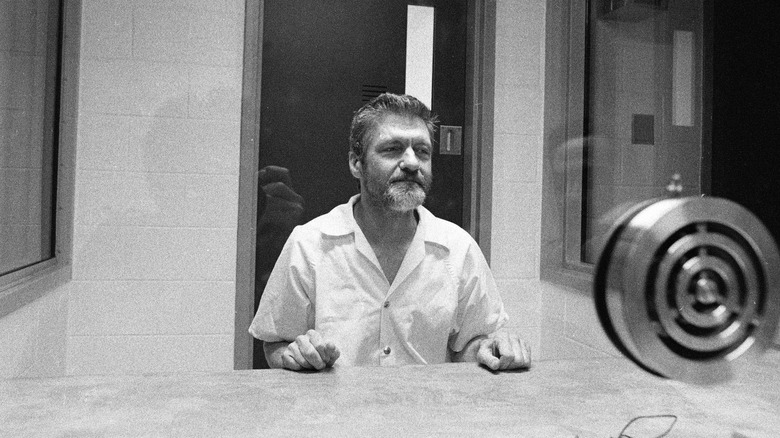True Crime Cases Solved By Unexpected People
In 2010, internet users were aghast at a brutal video posted online that appeared to show somebody suffocating two kittens to death with a plastic bag. Cats are famously beloved on the internet, and the video, which users immediately realized was posted in a sick attempt to garner attention online, with thousands soon joining an online community to track the poster down. Those with knowledge of such cases warned that the actions of the poster — whom they diagnosed as a malignant narcissist — would likely become more severe as time passed, and that he was at risk of soon seeking human victims. Indeed, their prediction came true. Despite the community attempting to warn the authorities of the danger, in 2012, the man behind the video and similarly gruesome follow-ups, a Canadian named Luka Magnotta, killed a man named Jun Lin, leading to a large-scale manhunt, with amateur sleuths again attempting to locate the killer through his internet footprint.
The story was so bizarre that many of those involved in the online sleuthing featured in Neflix's hit 2019 limited series, "Don't F*** With Cats: Hunting an Internet Killer," which detailed both the online community's monitoring of Magnotta and how investigators eventually captured him in an internet cafe in Berlin. He is now behind bars. But the Magnotta case isn't the only time that normal everyday people have been actively involved in trying to crack a case, aside from serving as witnesses. Here are four more major true crime cases that saw the interventions of everyday people play a crucial role in catching killers.
The 'carpool detectives'
True crime is big business in the world of entertainment; indeed, apart from the sensational stories that the genre covers, a major part of its attraction is the armchair sleuthing aspect of being a true crime viewer. Could you have put the pieces together faster than professional investigators? Or, in the case of limited series such as Netflix's "The Staircase," can you dream up a theory of what actually happened when the crucial details of the crime aren't available?
For four LA moms, the chance to become amateur investigators wasn't just the stuff of imagination: it actually ended up cracking a cold case, a dream scenario for many armchair sleuths. In 2005, the bodies of a local businessman and his wife were discovered near their ruined SUV, which had seemingly veered off the road and over a cliff. Despite appearing to be an accident, investigators soon grew suspicious of the scene and opened a murder investigation; however, it grew cold and was closed, with a possible double murder unsolved.
In 2020, one of the women who was to form the "carpool detectives" was in a journalism class when she heard about the story, and grew obsessed with the possibility of solving it. Recruiting the three others who would soon make up the crime-solving foursome, they cracked the case after more than two years' work, worryingly linking it to organized crime with the revelation that the businessman's business was being intimidated by the mob. The team is now looking to solve further cases.
The Jacob Wetterling Case
In 1989, 11-year-old Jacob Wetterling was abducted as he cycled home from a video rental store in St. Joseph, Minnesota. His friend and his younger brother were with Wetterling as they rode their bikes home early that evening. The young witnesses said he was taken at gunpoint by a masked man who told the other boys to run away from the scene without looking back or he would shoot them. Despite a major national appeal for information and a missing persons campaign on Jacob's behalf, years passed with no breakthrough in the case.
It was only in 2010, two decades after Jacob's disappearance, that things began to change. Joy Baker was a part-time blogger who began writing about Jacob's disappearance, and who soon linked it to an attack on another boy, 12-year-old Jared Scheierl, that had occurred in the area during the same period. She soon uncovered more cases and took her information to Patty, Jacob's bereaved mother, who supported Baker in her unofficial investigation. After DNA evidence led investigators to Scheierl's attacker, a local factory worker named Danny Heinrich, Heinrich confessed to abducting and killing Wetterling, finally bringing closure to the boy's family.
The Unabomber
The case of the Unabomber is one of the most terrifying and intriguing crime stories of recent decades. Between 1978 and 1995, universities and private homes across America were routinely targeted with homemade bombs that were either planted at the sites or that arrived in the mail. Over the course of more than a dozen attacks, 23 people were injured and three were killed.
Uncovering the identity of the Unabomber became a huge national issue, with a broad team of investigators engaged in finding the domestic terrorist before his attacks became even more catastrophic. But despite the involvement of a sprawling FBI task force of 150 investigators to track the Unabomber down, it was someone very close to the Unabomber who was finally able to provide the missing piece of the puzzle.
In 1995, The New York Times and Washington Post published a "manifesto" they had apparently received from the Unabomber, which was a screed against the effects of modern industrialization. A man named David Kaczynski recognized the unhinged language — it was how his brother, Ted, would talk. Kaczynski alerted the FBI of his brother's whereabouts, and the Bureau traced him to his shack in Montana, where they discovered bomb-making equipment. In January 1998, Ted Kaczynski pleaded guilty to the bombings and was given four life sentences plus 30 years behind bars as part of his plea deal. He died by suicide in prison in 2021 at the age of 81.
The Gabby Petito Case
Gabby Petito was just 22 years old when she and her fiancé, Brian Laundrie, set off on what was meant to be a dream road trip across the United States. The young couple charted their journey, which began on July 2 in Long Island, New York, in social media posts that portrayed the journey as a fun-filled and loving experience for them both.
Nothing could be further from the truth. As witnesses would later explain to the police, the trip quickly descended into an abusive relationship dynamic which involved physical violence, with Laundrie even seen hitting Petito. Eventually, in August, Petito's family lost contact with her, and Laundrie returned home alone, saying that he had left Petito behind. Meanwhile, Petito's family went public, begging the Laundrie family to come clean with what had happened to her. But Laundrie and his parents refused to share any more details.
A huge search was then underway for Petito, which went on for weeks without any sign of her. However, in late September, vloggers Jenn and Kyle Bethune shared that footage of what they said was Laundrie's van, parked in a remote location in Bridger-Teton National Forest. The footage was taken on August 27, before Laundrie returned in the van to Florida. The vloggers alerted the FBI to the footage, and Petito's remains were found nearby on September 19. By which time, Laundrie was already missing; his body, along with a written confession claiming that Petito's murder was actually an act of mercy — a claim which investigators have uniformly suggested was false — were discovered on October 20. What really happened between Petito and Laundrie is still a matter of debate.
A Missouri cold case
Up to 600,000 people are reported missing in the U.S. in any given year, and while a good number of those later show up alive and well, some of those are never seen again, appearing to disappear without a trace as their missing person case eventually grows cold. This is what appeared to happen with Donnie Erwin, a 59-year-old resident of Camdenton in rural Missouri.
On December 29, 2013, Erwin left his family home to buy cigarettes at a nearby convenience store, but never returned home. For 10 years, his family searched for answers to his disappearance, enlisting local people to try to find out what happened to him, while the police investigation came to nothing. It was only in December 2023 that the Erwin family finally found the answers they were looking for, after a true crime enthusiast and YouTuber, James Hinkle, developed an interest in the case and decided to use his drone piloting and scuba diving skills to conduct his own search of the area to scour for Erwin's remains, assuming that his car must have come off the road on the way to the convenience store.
It took Hinkle a year to find Erwin's car, which was submerged in a small pond invisible from the road, yet noticeable in drone footage. In the car was a titanium hip replacement, confirming his tragic fate but bringing closure to his family, who had been frustrated by the investigation for so long.




